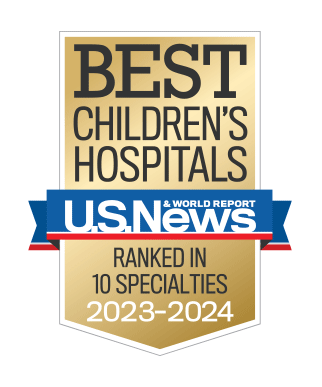Crossed eyes in babies are a cause for attention at a certain point in the first year.
During the first year of life, as children begin to experience the big wide world around them, their eyes, brain and vision develop quickly. Abnormalities in the way a child’s visual system develops can cause misalignments — what we typically refer to as “crossed eyes,” but a doctor may call “strabismus.” If your newborn appears to have a misalignment, it’s crucial that any suspected problems be addressed early.
“Having straight eyes is important for the development of binocular vision and depth perception,” said Dr. Sean Donahue, chief of pediatric ophthalmology at Monroe Carell Jr. Children’s Hospital at Vanderbilt, whose specialties include amblyopia and visual development. “Unfortunately, about 3 percent of children develop strabismus. Timely treatment by a pediatric ophthalmologist may prevent serious vision problems later in life.”
Unsure of your child’s visual development? Donahue answers some common questions on misalignments, how they arise and how they can be treated.
When should parents be concerned about crossed eyes?
“If a newborn is crossing their eyes for the first few months of postnatal life, this is relatively normal,” Donahue said. “However, any inward crossing after age 3 months, and any outward drifting after age 4 months, is not normal. This strabismus typically does not go away and warrants referral to a pediatric ophthalmologist.”
Donahue noted that the most common referrals for infants with crossed eyes during the first year of life are for children who appear to have crossed eyes, when in fact the eyes are straight. “A relatively wide nasal bridge can give the appearance of crossed eyes,” he said. “In this case, after a complete eye examination when dilating drops are used, we reassure the parents that all is well.”
What causes crossed eyes in children?
To understand the cause of misalignment, it’s important to understand the different types that can present: infantile esotropia and accommodative esotropia.
- “Infantile esotropia is characterized by a large-angle inward turning of the eyes that develops within the first 6 months of life,” Donahue said. “It can be associated with mild neurologic delay and is probably caused by the inability of the brain to interpret two images as a single image.” Treatment for infantile esotropia consists of eye muscle surgery. Eye muscle surgery is done as an outpatient procedure and usually involves both eyes.
- Accommodative esotropia is the most common cause of eye-crossing seen in children under the age of 5. “Accommodative esotropia is caused by excessive farsightedness, and the need to focus the eyes produces an inward crossing of the eyes,” Donahue explained. Treatment for accommodative esotropia involves correcting the farsightedness with glasses. These children typically do extremely well and can eventually transition to contact lenses as they get older.
A small percentage of children with accommodative esotropia develop eye crossing that cannot be corrected fully with glasses. “These children also need eye muscle surgery,” Donahue said. “The purpose of the surgery is to get the eyes straight with glasses on, not to eliminate the need for glasses.” Surgery is often performed as soon as the child has good vision in each eye and can cooperate well enough to measure the amount of misalignment.
What is amblyopia?
About 40 percent of children with esotropia develop amblyopia (more commonly called “lazy eye”). “Amblyopia occurs because the brain suppresses vision from the crossed eye,” Donahue said. “Treatment forces the misaligned eye to see by either patching the straight eye or using a drop that blurs vision in the healthy eye.” When treated before age 5, more than 80 percent of children diagnosed with amblyopia associated with esotropia eventually improve to the point of having legal driving vision in the amblyopic eye.
When should my child see an eye doctor?
If you feel your child has a problem with vision or eye alignment, ask your pediatrician for a referral to a pediatric ophthalmologist. Typically, your child will have his or her eyes dilated. Unfortunately, there is no way to appropriately assess a child’s vision without using dilating drops.

Personalized care when you need it
The Pediatric Ophthalmology care team at Monroe Carell Children’s Hospital at Vanderbilt is highly trained in caring for children’s eyes and vision.

